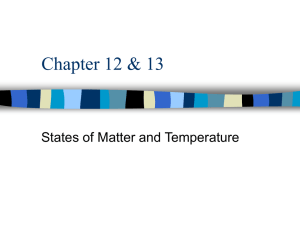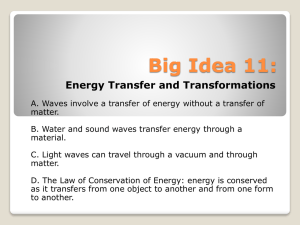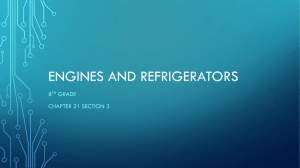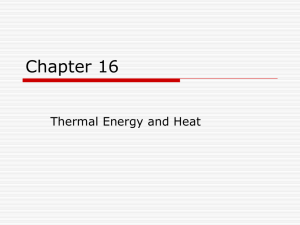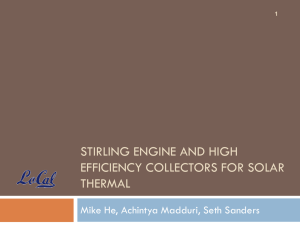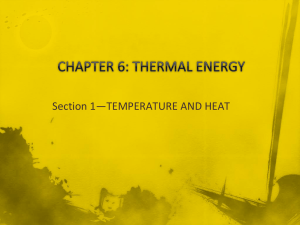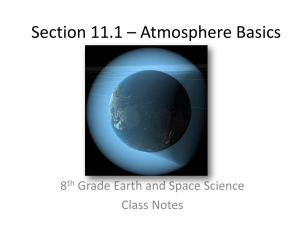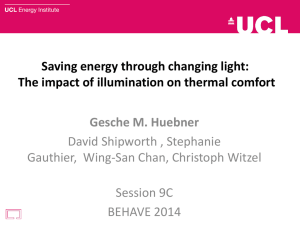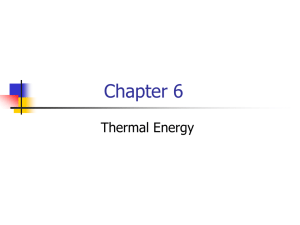Ch 16- Thermal Energy and Heat
advertisement
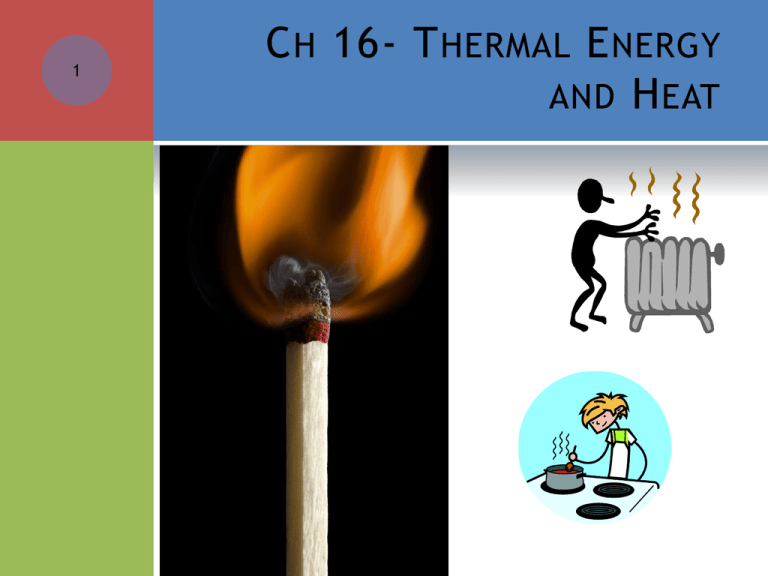
1 C H 16- T HERMAL E NERGY AND H EAT S ECTION 16.1: T HERMAL E NERGY AND M ATTER 2 Heat is the transfer of thermal energy from one object to another because of a temperature difference. Heat flows spontaneously from hot objects to cold objects. Temperature is related to the average kinetic energy of the particles in an object due to their random motions through space. 3 Temperature is a measure of how hot or cold an object is compared to a reference point. • • On the Celsius scale, the reference points are the freezing and boiling points of water. • On the Kelvin scale, absolute zero is defined as a temperature of 0 kelvins. As an object heats up, its particles move faster, on average. The average kinetic energy of the particles increases. W HAT TWO VARIABLES IS THERMAL ENERGY RELATED TO ? 4 Thermal energy is the total potential and kinetic energy of all the particles in an object. Thermal energy depends on the mass, temperature, and phase (solid, liquid, or gas) of an object. W HAT 5 CAUSES THERMAL EXPANSION ? Thermal expansion is an increase in the volume of a material due to a temperature increase. Thermal expansion occurs when particles of matter move farther apart as temperature increases. Ex. If you take a balloon outside on a cold winter day, it shrinks in a process of thermal contraction. • As temperature decreases, the particles that make up the air inside the balloon move more slowly, on average. • Slower particles collide less often and exert less force. • Gas pressure decreases and the balloon contracts. • In general, gases expand more than liquids and liquids expand more than solids. H OW 6 IS A CHANGE IN TEMPERATURE RELATED TO SPECIFIC HEAT ? Specific heat is the amount of heat needed to raise the temperature of one gram of a material by one degree Celsius. The lower a material’s specific heat, the more its temperature rises when a given amount of energy is absorbed by a given mass. Ex. When a car is heated by the sun, the temperature of the metal door increases more than the temperature of the plastic bumper. The iron in the door has a lower specific heat than the plastic in the bumper. 7 8 C ALCULATING S PECIFIC H EAT In this formula, heat is in joules, mass is in grams, specific heat is in J/g•°C, and the temperature change is in degrees Celsius. 9 C ALCULATING S PECIFIC H EAT An iron skillet has a mass of 500.0 grams. The specific heat of iron is 0.449 J/g•°C. How much heat must be absorbed to raise the skillet’s temperature by 95.0°C? W HAT 10 INFORMATION ARE YOU GIVEN ? 11 P LAN AND SOLVE … What unknown are you trying to calculate? What formula contains the given quantities and the unknown? 12 R EPLACE EACH VARIABLE WITH ITS KNOWN VALUE … S AMPLE 13 PROBLEM … How much heat is needed to raise the temperature of 100.0 g of water by 85.0°C? (remember, the specific heat of water is 4.18 J/g•°C ) Answer: Q = m * c * ∆T = (100.0 g)(4.18 J/g•°C)(85.0°C) = 35.5 kJ 14 O N WHAT PRINCIPLE DOES A CALORIMETER OPERATE ? A calorimeter is an instrument used to measure changes in thermal energy. A calorimeter is used to measure specific heat. A sample is heated and placed in the calorimeter. The temperature change is observed. 15 S ECTION 16.2: H EAT AND T HERMODYNAMICS Conduction, Convection and Radiation C ONDUCTION 16 Conduction occurs within a material or between materials that are touching. In conduction, collisions between particles transfer thermal energy, without any overall transfer of matter. Conduction is the transfer of thermal energy with no overall transfer of matter. Conduction in gases is slower than in liquids and solids because the particles in a gas collide less often. T HERMAL C ONDUCTORS 17 A thermal conductor is a material that conducts thermal energy well. Metals are good thermal conductors. The red arrows show how thermal energy is conducted away from the heat source in a metal frying pan. 18 T HERMAL I NSULATORS A material that conducts thermal energy poorly is called a thermal insulator. Air is a very good insulator. Wool garments and plastic foam cups use trapped air to slow down conduction. C ONVECTION 19 Convection is the transfer of thermal energy when particles of a fluid (including gases like air!) move from one place to another. Convection currents are important in many natural cycles, such as ocean currents, weather systems, and movements of hot rock in Earth’s interior. C ONVECTION 20 A convection current occurs when a fluid (including gases like air!) circulates in a loop as it alternately heats up and cools down. • Air at the bottom of an oven heats up, expands, and becomes less dense. The hot air rises. • Rising hot air cools as it moves away from the heat source. • As a result, the coolest air is at the top of the oven. R ADIATION 21 Radiation is the transfer of energy by waves moving through space. All objects radiate energy. As an object’s temperature increases, the rate at which it radiates energy increases. 22 R ADIATION When you stand to the side of a charcoal grill, heat reaches you without convection or conduction. The sun warms you by radiation on a clear day. The space between the sun and Earth has no air to transfer thermal energy. Heat lamps used in restaurants are another example of radiation. T HERMODYNAMICS 23 The study of conversions between thermal energy and other forms of energy is called thermodynamics. There are three laws of thermodynamics… F IRST L AW OF T HERMODYNAMICS : 24 The first law of thermodynamics states that energy is conserved. Energy cannot be created or destroyed, but it can be converted into different forms. Added energy increases the thermal energy of a system or does work on the system. In either case, energy is conserved. S ECOND L AW OF T HERMODYNAMICS : 25 The second law of thermodynamics states that thermal energy can flow from colder objects to hotter objects only if work is done on the system. Thermal energy flows spontaneously only from hotter to colder objects. • A refrigerator must do work to transfer thermal energy from the cold food compartment to the warm room air. • The thermal energy is released by coils at the bottom or in the back of the refrigerator. E NTROPY 26 Spontaneous changes will always make a system less orderly, unless work is done on the system. Disorder in the universe as a whole is always increasing. Entropy is the measure of the disorder of a system. T HIRD L AW OF 27 T HERMODYNAMICS The third law of thermodynamics states that absolute zero cannot be reached. S ECTION 16.3: U SING H EAT 28 The two main types of heat engines are the external combustion engine and the internal combustion engine. A steam engine is an external combustion engine—an engine that burns fuel outside the engine An internal combustion engine is a heat engine in which the fuel burns inside the engine. Most cars have internal combustion engines. 29 H EAT E NGINES In an internal combustion engine, the cooling system and exhaust transfer heat from the engine to the environment. Gasoline engines are more efficient than old-fashioned steam engines, but they still are not very efficient. About one third of the energy in a gasoline engine is converted to work. H OME H EATING 30 Most heating systems use convection to distribute thermal energy. A central heating system heats many rooms from one central location. • The most commonly used energy sources for central heating systems are electrical energy, natural gas, oil, and coal. • Heating systems differ in how they transfer thermal energy to the rest of the building. • Different methods of home heating are available. Some more efficient than others!

